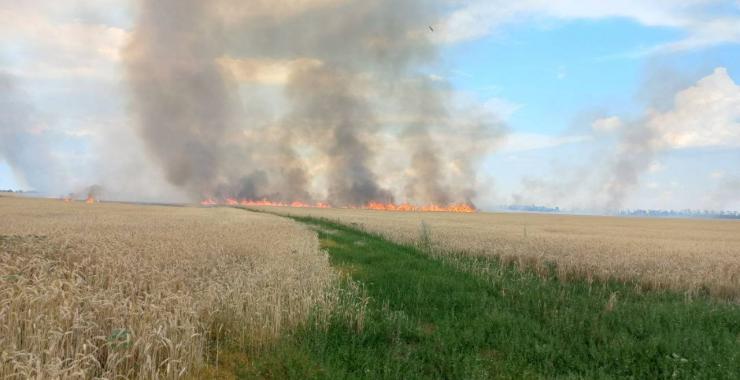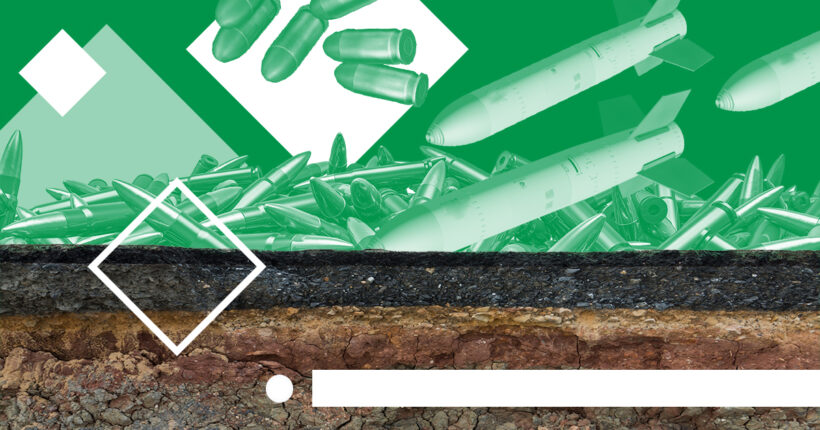
What is the problem?
How does war affect soils?
In our latest articles that you can find on Ecorubric, we gradually examined each of Ukraine's ecosystems damaged by military actions. We've already talked about the damage caused to natural and artificial forests and the depletion and pollution of Ukraine's water resources. Still, the soil ecosystem suffers the most among the ecosystems negatively affected by military actions.
What is under our feet is an entire ecosystem. Many tiny organisms create and maintain the soil and biological cover—grasses, mosses, lichens, and fungi. They are most vulnerable due to their lack of mobility. In other words, all living organisms in the soil layer or those that protect its surface from erosion cannot leave the area where the munitions explode or defend themselves from harm. These results are primarily the short-term destructive effect of the blast wave and the long-term impact of chemical pollution.
What happens to the soil after shelling?
The image shows a section of fields sown with winter crops in the Kharkiv region—its area is approximately one km². Using the method created by environmentalists from the Environment–People–Law International Charity Organization, experts of the Ukrainian Nature Conservation Group, counted 480 funnels from shells.
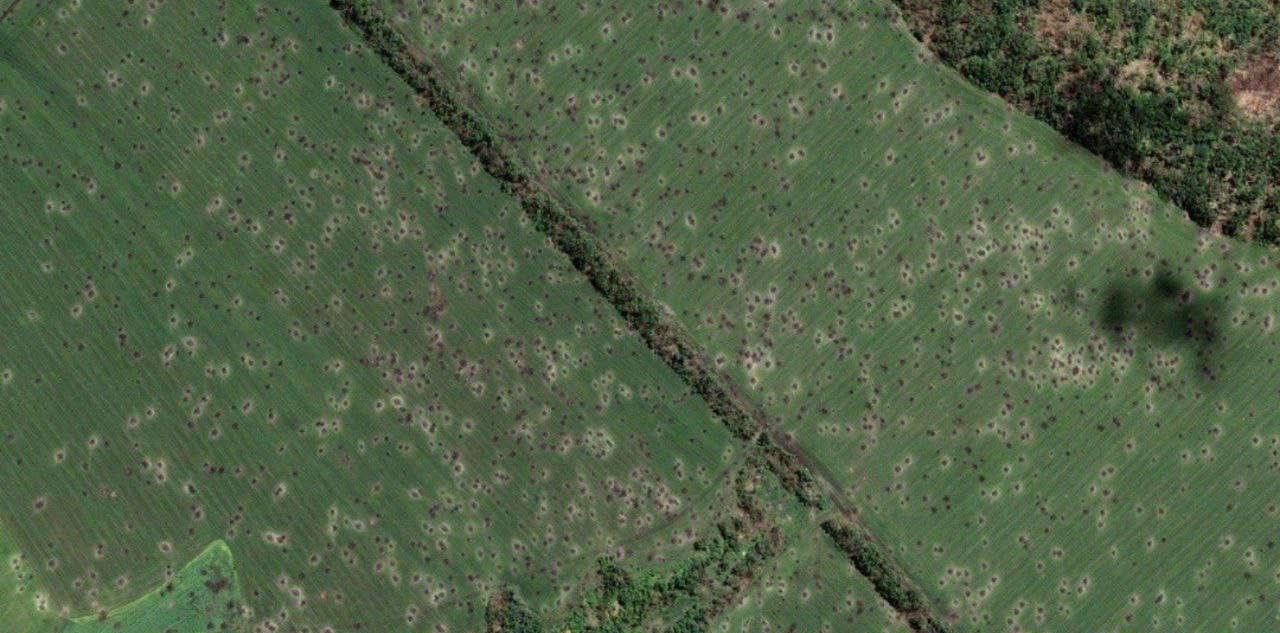
The damage from explosions in the fields is enormous. Just look at the pictures of the fields in the Kharkiv region's Izium district; here, you can count about 500 funnels from shells
As a result of the shelling, the flat surface of the field is damaged, missile fragments fall into the soil, and toxic gases are released into the atmosphere. So, what happens:
☠️ Fragments of projectiles. Ammunition casings are made of cast iron alloy. Besides iron and carbon, sulfur and copper are added to the mix. If the fragments remain in the ground, over time, they begin to oxidize, enter the cycle of environmental substances and enter food chains. In addition, some of the munitions have elements made using depleted uranium. According to calculations taken from a study by the Ukrainian Nature Conservation Group, 50 tons of iron, 1 ton of sulfur compounds, and 2.35 tons of copper got into the soil because of the shelling of just one square kilometer of the field in the Kharkiv region—these are only the substances with the highest content.
☠️ Toxic gases. In addition, during the explosion of even one kilogram of explosives, several tens of cubic meters of such toxic gases as sulfur oxide, nitrogen oxide, and carbon monoxide are released into the atmosphere. Finally, sulfur and nitrogen oxides from the atmosphere are returned to the soil through acid rain, which changes the pH of the ground and causes plant burns. It turns out that the soil becomes the final link of chemical damage by ammunition.
☠️ The blast wave causes large-scale destruction. Experts' calculations show that at least 90,000 tons of soil were uprooted by explosions on the field we're considering as an example. First, it will be necessary to spend a lot of fuel to level the field's surface. Second, filling in the crater isn't enough because the soil at the crater's edges is significantly compressed. Such soil is considered degraded because the intensity of the processes that dominated the pre-war soil landscape has changed (humification, leaching, weathering, and, of course, water circulation). Different soil formation processes will inevitably lead to changes in soil composition, as in Central Europe, where people still have to face it after the First World War. The speed of soil recovery is incredibly time-consuming. The global average rate of its formation is about 0.06 mm/year. In addition, explosions kill vegetation. It is pretty logical.
☠️ Damage to the soil's waterproof layer and ingress of pollutants into aquifers. Powerful explosions can destroy a waterproof layer of country rock. In this case, the water release into the soil is accelerated. The water doesn't linger in the hole but erodes its walls even more. It speeds up the organic matter deposition within the soil profile and promotes soil oxidation. Thus, aggressive pollutants enter aquifers and waterways. Some of them can be carried far beyond the battlefield. For example, in municipalities near the so-called "red zone" in France (several territories in the country's northeast where active hostilities took place during the First World War; more than 1,200 km² of fertile land in the area of the Battle of Verdun were recognized by the authorities as "completely destroyed"), in 2012, the authorities banned drinking water due to the excessive content of perchlorate, which is used in rockets and ammunition production. Such pollution can significantly affect people's safety and health.
The war continues, and hundreds of wounds are added to the surface of Ukraine's land every day. Living organisms die, water and soil deteriorate, and fields become unusable until the surface is restored and the demining is complete. What should Ukrainians do with such areas, and will they be suitable for use at least after minimal restoration?
What is the solution?
Reserves or demining
In short, there are two ways: leaving the territory and setting up a nature reserve or demining it long, expensively, and with a risk to people's lives.
Yulia Avramenko, an expert and project coordinator of the Ekoltava public organization, confirms that even if we decide to leave the site, first, it must be cleaned from the remains of shells, mines, etc. so that they don't continue to pollute the soil for many years in a row.
The second step is the reclamation of damaged lands. At the same time, the expert stresses that these measures aim to return and restore land for agricultural activities, forestry, fishing, and public and industrial use.
"In this case, we're not talking about recreational and agricultural use because of the threat to human health," Ms. Avramenko states.
Another option the expert gives as an example is removing the site from use with subsequent conservation and a ban on visiting.
"Ukraine has a similar experience—self-sowing forests formed after closing collective farms. It will take more than a dozen years, but they will be able to restore the overall ecological balance and become a home for many species of animals and plants," the expert explains.
We have already mentioned the Red Zone ("Zone Rouge") in France above; it's one example of such land "abandonment." The Battle of Verdun was the first battle in history to use artillery. The fighting itself between the French and the Germans lasted about 300 days, as a result of which, as the testimony of the British historian Christina Holstein shows, the ground was covered with cartridges and debris from heavy artillery shells:
"The ground was just completely smashed. Trees were uprooted, and people hid wherever they could, in holes from shells and in the ground," Holstein writes.
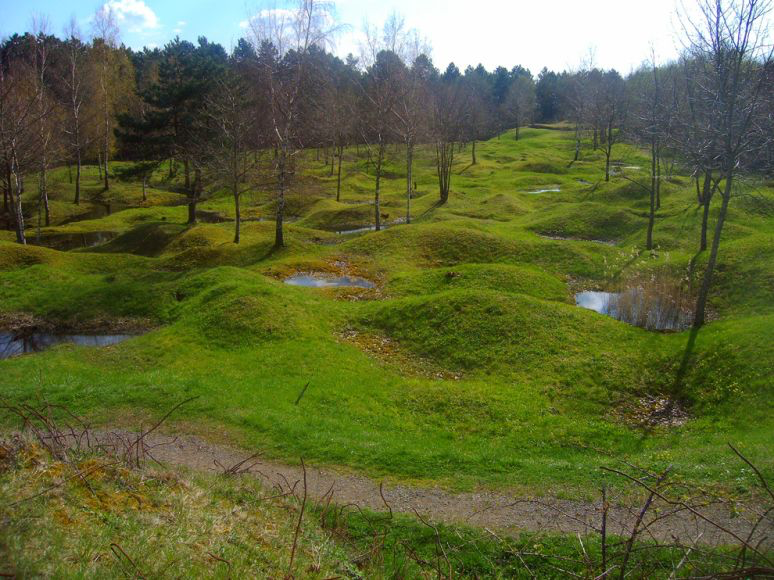
The photo shows the Red Zone in France, our time. This terrain is not natural, but one that appeared due to artillery fire more than 100 years ago.
After the war ended, the authorities introduced a strict ban on access to this territory; any agricultural activity on the land was prohibited. It's evident because all the villages in the not very densely populated region were destroyed by artillery.
Subsequently, through mopping up, the area of the affected area was reduced to 100 km² (approximately the size of Paris). However, it's still forbidden to enter some areas, and unexploded shells and their fragments can still be found on the territory.
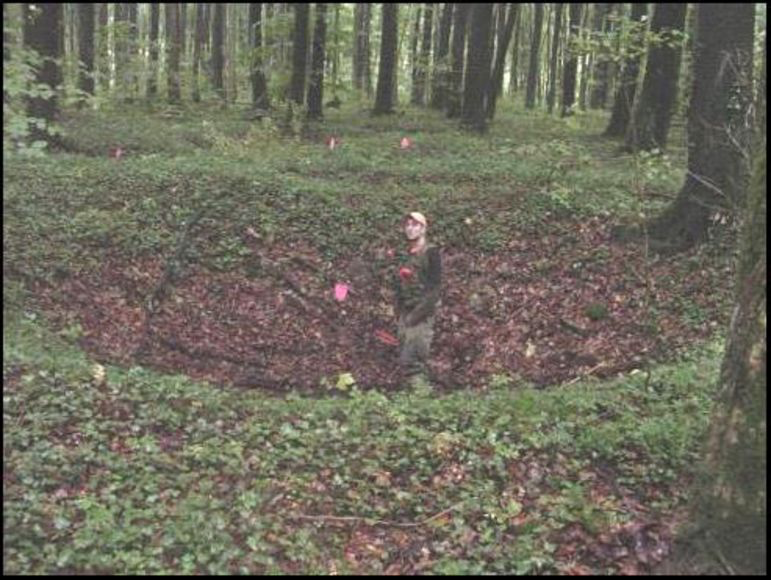
Red Zone in France, an artillery shell crater.
The first industrial pig farm was established here in 1929, in a less dangerous area. Today, the leading industries in France's Meuse region are "memory tourism" with an emphasis on Verdun and other battlefields, and agriculture—it's natural for people to return to their land, even if it's dangerous:
"Every year, there are farmers who come across shells: they get stuck in the tines, and tractors explode," says Joseph Hupy, a geography professor at the University of Wisconsin-Eau Claire who specializes in military geography.
Demining work in the area is still incomplete, and Holtstein says local authorities estimate 300 years are needed to clear the area at the current rate completely. However, Professor Joseph Hupy noted that this area would never be "restored" to the state it was in before the First World War. However, he also emphasizes that the area has changed, has become overgrown with trees, and now the region has a thriving woodworking industry.
Regardless of a country's economic status, millions of mined hectares remain off-limits worldwide—in North Africa, Asia, South America, and Europe. In Libya, a third of its land is contaminated by mines and unexploded ordnance from World War II.
Usually, states whose lands have been seriously damaged by shelling offer to remove bombarded and mined territories from cultivation. France made such a decision in 1918, and the countries of the Balkan Peninsula did after the 1999 war (due to soil contamination from rocket bursts, 120,000 hectares and 2.5 million hectares of land were taken out of use, respectively). Given the chemical and sometimes radioactive contamination of soil and water in different areas, nature is restored in different ways. In some places of the Red Zone, vegetation could not recover even after more than a century.
Rehabilitating land scarred by craters is expensive and resource-intensive. Therefore, sometimes the authorities conclude that it will be cheaper for the war-bled country and safer for the locals to leave the territories for a while and undertake a long, gradual demining and clearing of the land from dangerous remnants of war and debris.
It is also worth paying attention that sappers actively demine Ukrainian territories; in mid-June, the number of demined areas amounted to 2 million hectares. However, another 30 million remain mined, so perhaps the scenario where the authorities will protect war-torn lands is the most rational for some areas of Ukraine, where fields have been particularly affected by hostilities. However, there is still a way to "restore" the soil. Expert Yulia Avramenko explained:
"Soil rehabilitation at shelling sites consists not only in demining but also in further cleaning the land of other chemical residues that remain in the soil after the war. It is necessary to conduct soil testing to determine the content of heavy metals in the fields that have been shelled, and only after that to choose appropriate measures," says Ekoltava's expert.
The following measures are used to clean soils from heavy metals:
- If the soil is acidic, liming is carried out; if it's alkaline, plastering is used. It will convert heavy metals into immobile forms, and they will not be able to penetrate through the root system into the plant and fruits.
- Organic ion-exchange substances, such as polystyrene granules and zeolites, are added to the soil.
- In the first years of the reclamation, crops that can't accumulate heavy metals and technical crops (cotton, flax) are planted on the fields, and the officials constantly monitor the physical and chemical properties of the soil.
Newsletter
Digest of the most interesting news: just about the main thing




